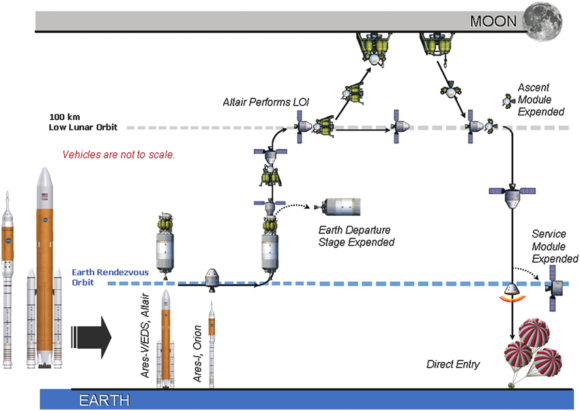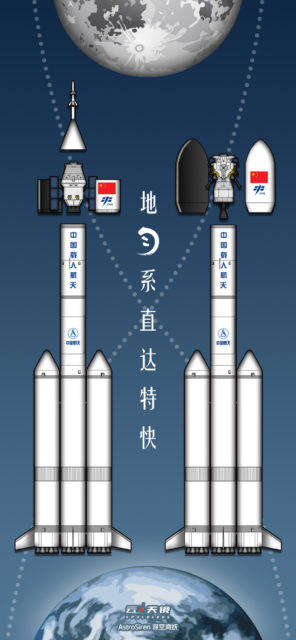The first lunar landing mission in NASA's Artemis program, Artemis 3, was recently delayed to 2026, but is unlikely to be able to lift off on that date. These delays are making many at NASA nervous, especially since China's first manned mission to the Moon will take place before the end of 2030. Since the delay comes primarily from the development of SpaceX's HLS Option A lunar module — and the Axiom diving suits — some wonder whether The architecture chosen is not overly complex due to the large number of launches needed to send the lunar module to the Moon (about ten). Since Blue Origin's lunar module, Blue Moon Mark 2, will also require multiple missions and won't launch until the Artemis V mission, is there a way to speed up these plans?

One possibility is to invest more money and resources into the spacecraft, but another possibility is to forget about it, even for now Moon ship SpaceX and introducing a new, simpler architecture. The latter is precisely what Mike Griffin, former NASA administrator between 2005 and 2009, proposed to the US Congress last week. Griffin spared no qualifications for the current configuration of Artemis, a program that, in his words, is “extremely complex, with an unrealistic budget, jeopardizes crew safety, carries significant risks of not being able to complete the mission and is unlikely to be ready on time until If it works” (come on, the guy is clearly thrilled with the program). By “timely”, Griffin is clearly referring to China. Griffin recommends canceling contracts with SpaceX and Blue Origin and introducing a much simpler architecture that uses the SLS rocket exclusively. Instead of more than a dozen Starship System missions and one SLS Block 1 with the Orion spacecraft, there will be only two launches of SLS Block 2 rockets. One to send the lunar module to the Moon and one for the Orion spacecraft with the crew. . Each launch will include a Centaur III stage that will be responsible for inserting the lunar module and Orion spacecraft, respectively, into low lunar orbit. The Orion module will dock in lunar orbit with the lunar module, and the four astronauts will explore the lunar surface for seven days. The reason for adding this upper stage is that the Orion spacecraft's service module has a delta-V rate of only 1.25 km/s, which prevents it from being placed directly into such an orbit and then returning to Earth. For this reason, an elliptical orbit of the NRHO type was chosen (Near the rectilinear orbit of the corona) for the Artemisa program.

The lunar module will be of a new design and will use a classic two-stage disposable configuration with hyperactive propellant to facilitate its development. In other words, it would serve as a kind of big Apollo LM. Depending on the final design, the Lunar Module's third centaur stage could be eliminated by making the module's descent stage larger. This structure increases the safety of the lunar expedition by allowing a return to Earth at almost any time, while Artemis' NRHO orbit allows only one launch from the lunar surface every 6.5 days (orbit period). Griffin's plan seems simple, but be careful with the finer details. On the one hand, the Centaur III stage would have to be launched from the lunar module half-full and then loaded to the brim with liquid hydrogen and oxygen, so in reality more than two launches would be necessary. On the other hand, in addition to building a new lunar module from scratch, it will be necessary to introduce the SLS Block 2, capable of sending 45 tons of cargo to the Moon (in the cargo version) or 41 tons in the manned version. Let us remember that SLS Block 1 is currently in use, and only with Artemis IV will the Block 1B version be offered, with the EUS upper stage. Development of Block 1B has been riddled with delays and cost overruns – especially due to the new launch platform – so it is expected that delivering Block 2 will not be an easy task. Block 2 will require the development of new, more advanced and powerful accelerators, but this version has not been approved for rollout and it will take many years before that happens, if that day comes.


The new lunar module could be similar to some of the designs we've seen in recent years, such as proposals from Boeing or Lockheed Martin from 2019. Griffin's plan is somewhat reminiscent of the Bush administration's constellation program to put humans on the moon before 2020, which Obama has canceled. mission in 2010. Constellation also planned two launches, but one using the Ares 1 rocket, a relatively low-powered rocket, and one using the massive Ares 5 rocket, which was very large specifically to mitigate the disadvantages of the Ares 1 rocket. Twice as powerful as the European Orion service module, which inherits the specifications of the Lockheed Martin constellation module. However, Constellation had a crucial difference, which was that it used an EOR structure rather than a LOR, meaning that Orion docked with Altair in Earth orbit, not the Moon. To compensate, the Constellation Lunar Module, Altair (LSAM) was to be responsible for placing the complex in lunar orbit.


During his time at NASA, Griffin tried to push the Constellation program forward, so it's only natural that he would have a penchant for similar architecture. But in reality, Griffin's plan looks more like the architecture of China's lunar program, with two CZ-10 rocket launches. The difference is that China's new manned spacecraft and lunar module are smaller and lighter than Orion and this new lunar module — the CZ-10 can put 70 tons into low Earth orbit — but the rest is very similar, including the use of an upper stage coolant, LOR architecture and propulsion. Overload of the lunar unit. In a way, it's only natural that we would want to confront China using its same architecture (in fact, the date of the first moon landing after Griffin's proposal is 2029, not a coincidence). In any case, Griffin's plan will go nowhere, except perhaps if the spacecraft continues to fail without reaching orbit for years (several Other years, that's understandable.) More than anything else, because NASA doesn't have the money for this new plan. Of course, Artemis' current build is more powerful when it comes to carrying cargo to the moon's surface, but what it's about here is being first in this new lunar race. As Griffin put it, “China cannot be allowed to defeat the United States and its allies and send them back to the moon.”

References:

“Beeraholic. Friend of animals everywhere. Evil web scholar. Zombie maven.”
